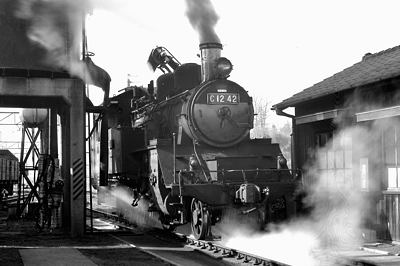
C12 No.42
... waiting to present itself on stage,
proudly waits its moment in time at Ena depot.
Japanese
|
1932 - 1975 A light Tank-Engine for light grade lines. |

C12 No.42 ... waiting to present itself on stage, proudly waits its moment in time at Ena depot. |
|
New branch line construction was activated during 1920 and the 1930's in Japan.
However, construction plans were affected by the economic depression of the 1930's.
As a result, the factor of "Cost Cutting" was an added consideration and resulted in the creation of "Very Light Grade Lines".
This Light Grade construction, resulted in the creation of the C12, which in effect, replaced old imported engines. Basically,
the C12 was designed from the C10, but was a smaller version.
The first C12 was manufactured at Kisha Seizo Co., it has the manufactured number of 1182 and she was active on the Oito line (Itoigawa depot) during her twilight years, but she was retired in July 1962 and scrapped.
And a total of 66 engines were moved out to Indochina, Northern China, and Sakhalin in WW2. Of these sent to Northern China, 60 engines were converted to narrow gauge. (1067mm 3ft-6in -> 1000mm). And three engines were sold to private railway companies during WW2, No.56 to the Sagami Railway during July 1944, No.97 to the Mitsui-Miike mine railway during February 1944, and No.98 to the Tokuyamay Soda Co. during 1944. (* JGR - 293, Taiwan R.- 7, Private R. - 19, Total - 319) During 1941, one C12 was ordered from Karafuto Railway (currently South-Sakhalin in Russian territory.) as a Karafuto Railway's Class C12 No.1. When the Karafuto railway was integrated with the Japanese government railway during 1943, C12_1 was transferred to the JGR and renumbered with the JGR C12's No. 265. Also during 1942-1943, 3 more C12s were ordered from Karafuto Railway. When placing an order, they were named the class C12 No.2 - No.4, but they were completed as the JGR class C12 No.271-273. These four No.265, 271, 272 and 273 engines were lost by the wars end. During 1941, Kokura Railway Co. (currently JR-Kyushu Hita-Hikosan line) ordered four C12s Kokura Railway No.11-14 and were completed as the JGR class C12 No.267-270, because of Kokura railway Co. nationalization during 1943. Also during 1942, Sagami Railway (currently JR-East Sagami line) ordered two C12s (Sagami Railway No.21, 22) and were completed as the JGR No.274, 275, from Sagami railway nationalization during 1944. Bantan Railway Co (currently JR-West Bantan line) ordered one and was completed as the JGR No.266 from nationalization during 1943. Following is a summary of those delivered to owners : No.1-264 Government Railway, pre WW2 (1932-1940) No.265 Karafuto Railway ex-C12_1 No.266 Bantan Railway (retired Moji depot during Dec 1961) No.267 Kokura Railway ex-C12_11 (retired Yoshizuka depot during Dec 1965) No.268 Kokura Railway ex-C12_12 (retired Shimonoseki work office during Feb 1961) No.269 Kokura Railway ex-C12_13 (retired Hamamatsu workshop during Aug 1967) No.270 Kokura Railway ex-C12_14 (retired Gotoji workshop during Oct 1962) No.271 Karafuto Railway ex-C12_2 No.272 Karafuto Railway ex-C12_3 No.273 Karafuto Railway ex-C12_4 No.274 Sagami Railway ex-21 (retired Kozu depot during Jan 1961) No.275 Sagami Railway ex-22 (retired Tabata depot during Jan 1961) No.276-293 Government Railway (JNR), after WW2 (1947) C12 continued to be used in many of the light grade lines after WW2. After WW2, 223 C12s were still active all over on Japanese local lines and yard work, with the exception of 60, which were moved out to overseas, and 1 war-damaged (No.196), and 3 (No.56, 97 and 98) were sold to private railways. No.96 was sold to the Yubetsu Railway Co. during March 1959. She was scrapped by 1970 as the railway company was closed. Gradually dieselization began from 1960 and about 20 were left in 1973. The last surviving C12s were Kumamoto depot's two No.208 and 241. No.208 pulled the Good-Bye steam train on the Takamori line on the 9th of March 1975 and all C12s were retired during that same day. About 30 C12's were preserved. And two engines were restored, C12_66 of the Moka Railway Co and C12-164 of the Oigawa Railway Co. But Oigawa railway's C12_164 is out of service right now. |
| Primary ran line in last 10 years |
Temiya, Nittyu, Ashio, Aketi, Takamori etc ....
| Last line/depot and year |
Takamori line / Kumamoto depot Mar.1975
| Restored engine (2017) |
2 (No.66, 164)
| Preserved engine (2017) |
28
| |
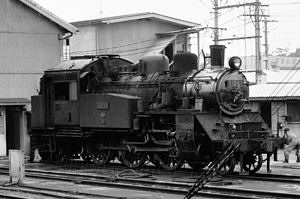
|
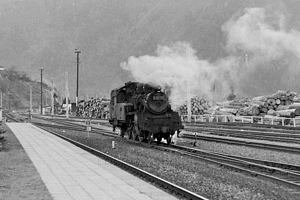
| ||||||||||||
|
This scene depicts a C12 engine at Kiryu depot on Ashio line during its last service period in Tokyo's Kanto area. C12_47, Kiryu. Jul 1969. |
C12_171,shunting in Agematsu yard
| 
| 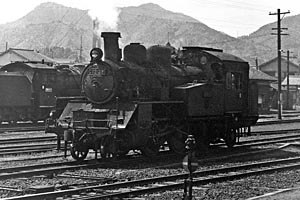
We see a C12 ascending a grade, | highlighted in evening twilight. Akechi line Nov 1970.
C12_32 on the Higashi-Maizuru yard. | During 1970.
| 
| 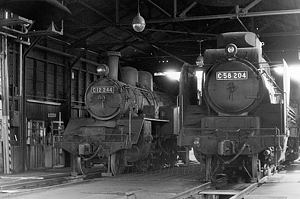
With the first frosts of an early winters morn, | another day begins with a cloud of steam and C12's passage. Akechi line, Dec 1971.
C12_244 with C58_204 | Nishi-Maizuru depot.
| 
| 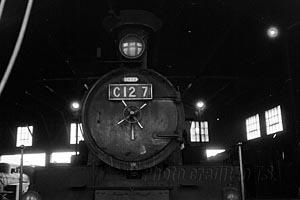
Ashio line's turn headed C12. | Nov 1968 Omama.
C12_7 on the Takasaki depot. | During 1967. |
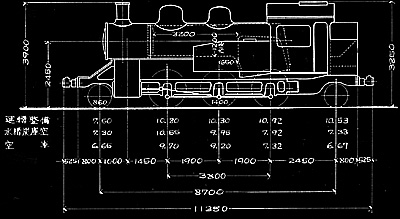
| Configuration | 2-6-2 | Dimensions Length (mm) | 11350 |
| Engine Weight (Operating tons) | 50.1 | Driver size (mm diameter) | 1400 |
| Boiler pressure (Kg/cm2) | 14.0 | Max Tractive effort (tons) | 8.0 |
| Driver Max Power (PS) | 505 | Max Speed (km/h) | 75 |
| Manufactured years | 1932-1940 1943,44,46,47 | Total production (National Railways) | 293 (282) |
| Number of moved out to other countries in WW2. | 66 | Gauge | 3ft 6in (1067mm) |
Introduction |
Go to Top |